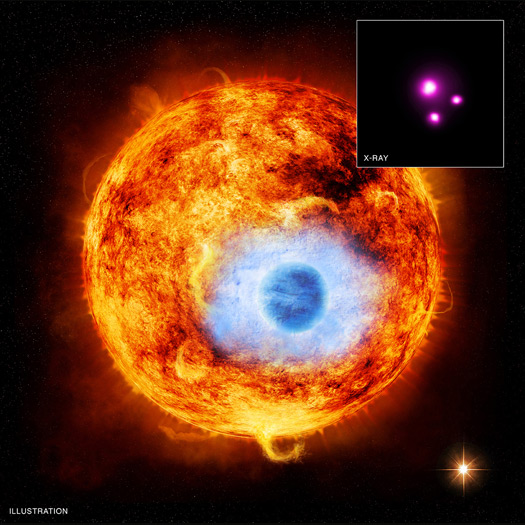For Release: July 29, 2013
NASA

Credit: X-ray: NASA/CXC/SAO/K.Poppenhaeger et al; Illustration: NASA/CXC/M.Weiss
Press Image and Caption
RELEASE: 13-237
NASA's Chandra Sees Eclipsing Planet in X-rays for First Time
For the first time since exoplanets, or planets around stars other than the sun, were discovered almost 20 years ago, X-ray observations have detected an exoplanet passing in front of its parent star.
An advantageous alignment of a planet and its parent star in the system HD 189733, which is 63 light-years from Earth, enabled NASA’s Chandra X-ray Observatory and the European Space Agency’s XMM Newton Observatory to observe a dip in X-ray intensity as the planet transited the star.
"Thousands of planet candidates have been seen to transit in only optical light," said Katja Poppenhaeger of Harvard-Smithsonian Center for Astrophysics (CfA) in Cambridge, Mass., who led a new study to be published in the Aug. 10 edition of The Astrophysical Journal. "Finally being able to study one in X-rays is important because it reveals new information about the properties of an exoplanet."
The team used Chandra to observe six transits and data from XMM Newton observations of one.
The planet, known as HD 189733b, is a hot Jupiter, meaning it is similar in size to Jupiter in our solar system but in very close orbit around its star. HD 189733b is more than 30 times closer to its star than Earth is to the sun. It orbits the star once every 2.2 days.
HD 189733b is the closest hot Jupiter to Earth, which makes it a prime target for astronomers who want to learn more about this type of exoplanet and the atmosphere around it. They have used NASA's Kepler space telescope to study it at optical wavelengths, and NASA's Hubble Space Telescope to confirm it is blue in color as a result of the preferential scattering of blue light by silicate particles in its atmosphere.
The study with Chandra and XMM Newton has revealed clues to the size of the planet's atmosphere. The spacecraft saw light decreasing during the transits. The decrease in X-ray light was three times greater than the corresponding decrease in optical light.
"The X-ray data suggest there are extended layers of the planet's atmosphere that are transparent to optical light but opaque to X-rays," said co-author Jurgen Schmitt of Hamburger Sternwarte in Hamburg, Germany. "However, we need more data to confirm this idea."
The researchers also are learning about how the planet and the star can affect one another.

